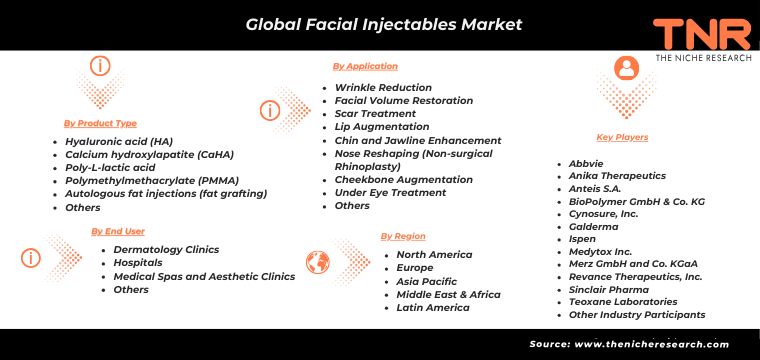The increasing focus on aesthetic appearance and the growing acceptance of non-surgical cosmetic treatments drive the growth of the facial injectables market. The facial injectables market is witnessing a confluence of established and evolving trends:
Rising Popularity of Non-Surgical Procedures: Non-surgical facial treatments, such as Botox and dermal fillers, are becoming increasingly popular due to their minimally invasive nature, shorter recovery times, and effective results in enhancing aesthetic appearance.
Technological Advancements: Innovations in facial injectables, including the development of longer-lasting and more natural-looking fillers, are driving market growth by offering improved outcomes and meeting the evolving needs of consumers seeking advanced aesthetic solutions.
Growing Male Demographic: The facial injectables market is witnessing a significant increase in male clients, driven by the rising acceptance of cosmetic treatments among men aiming to maintain a youthful appearance and enhance their facial features.
Expanding Applications Beyond Aesthetics: Beyond traditional aesthetic uses, facial injectables are increasingly being utilized for medical applications such as treating migraines, hyperhidrosis, and facial muscle spasms, broadening the market’s scope and attracting diverse patient segments.
Regional Landscape: North America Leads the Way
North America leads the facial injectables market due to high consumer awareness, advanced healthcare infrastructure, and the prevalence of skilled professionals. The region’s growing demand for minimally invasive aesthetic procedures further propels market growth, with the United States at the forefront.
Product Type Segmentation: Hyaluronic acid (HA) Remain Dominant
Hyaluronic acid (HA) remains dominant in the facial injectables market due to its superior moisturizing properties, natural compatibility with the skin, and ability to provide immediate, long-lasting results, making it a preferred choice for both patients and practitioners.
Recent Developments: Companies Drive Innovation
Leading companies in the facial injectables market are actively involved in research and development to introduce innovative products, expand their portfolios, and enhance treatment outcomes. Strategic collaborations, mergers, and acquisitions further strengthen their market presence and competitive edge globally.
Allergan Healthcare: Allergan Healthcare India introduced Juvéderm VOLUX, an injectable implant designed for facial volume restoration and creation, under the Allergan Aesthetics division.
Merz Aesthetics: Merz Aesthetics released Radiesse (+), the first and only aesthetic injectable aimed at enhancing moderate to severe jawline contour loss.
Sinclair Pharma: Sinclair Pharma granted Galderma SA the distribution partnership rights for Sculptra (a poly-L-lactic acid injectable) specifically for the European market.
Looking Ahead: A Sustainable & Innovative Future
The future of the facial injectables market looks promising, driven by continuous advancements in technology and increasing consumer demand for minimally invasive aesthetic procedures. Innovations such as longer-lasting and more natural-looking injectables, along with personalized treatment plans, are expected to enhance patient satisfaction. Additionally, expanding applications of facial injectables in medical treatments, such as for migraines and hyperhidrosis, will further propel market growth. The rise in social media influence and growing acceptance of cosmetic enhancements among both men and women are also significant factors. The market is set for substantial growth, offering diverse and improved solutions for facial rejuvenation.

